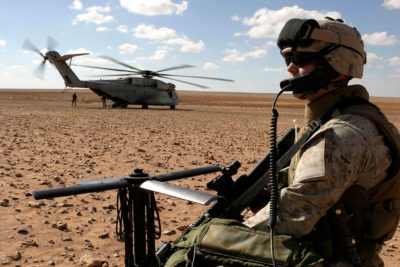As a premier manufacturer of fiber optics for military communications, we are going to take a look at some of the advantages of fiber optics compared to copper communications and how the military uses fiber optics in tactical applications. We will also explore some of the different connector systems and where they are used.
Fiber optics provides several benefits compared to copper connectivity: it’s lighter and smaller, has higher bandwidth, has lower loss, it’s spark-free and immune to Electromagnetic Interference (EMI), and fiber optics is a more secure transmission. On the flip side, fiber optics has an image problem when it comes to durability and the transmission equipment can be more costly than its copper counterparts. I say an image problem because the perception is that because fiber optics is made of glass, it is weaker. While fundamentally, yes, glass is “weaker” than copper by many measurements (tensile strength being a key exception), the cabling itself is all built to the same durability specifications.
 Military tactical cable is built to be rugged, lightweight and flexible. This facilitates rapid deployment in mission-critical applications. The construction and ratings may vary from one application to the next, but military cable tends to be tailored to the environment in which it will be deployed.
Military tactical cable is built to be rugged, lightweight and flexible. This facilitates rapid deployment in mission-critical applications. The construction and ratings may vary from one application to the next, but military cable tends to be tailored to the environment in which it will be deployed.
The US Navy uses a style of cable known as shipboard cable, controlled by the MIL-PRF-85045 cable standard. These cables utilize a Low Smoke Zero Halogen (LSZH) jacket and 2.0mm sub-units. Ground tactical units use multi-fiber cables with a tough Polyurethane outer jacket. Military fiber optic cables traditionally use either OM1 MM fiber or OS2 SM fiber allowing for use in a variety of applications. These cables are ideal for use with circular multi-ferrule connectors.
Connectors for military use come in a variety of options, each with its own variety of options. The type of connector you choose really depends on the application it’s intended for. The M28876, D38999 and NGCon connectors are popular with the Navy. TFOCA/QFOCA connectors are popular for ground tactical communications. Fischer Connectors has a proprietary line of gas-tight 1, 2 and 4 channel connectors that are popular with ship-to-shore communications and ROV tethers.
The D38999 and M28876 connectors utilize gendered termini, pins and sockets, and are available as plugs, jam-nut receptacles and flange-mount receptacles. A plug with sockets would mate to a receptacle with pins. NGCon connectors combine elements of both the D38999 and M28876 and have a square, miniturized version. Each of these options are available in multiple plating, channel and keying options. Circular connectors are great for trunking communications on a vessel or vehicle and for ship-to-shore communications.
Hermaphroditic connectors are one of the more popular connectors for ground tactical communications. Hermaphroditic connectors are genderless and do not require a separate adapter to mate connectors in the field. They feature ferrules and an insert that contains the alignment sleeves. The plugs can mate to each other for quick extension of cable runs. These MIL-PRF-83526 heading connectors come in a variety of brand names: TFOCA, QFOCA, GFOCA, DFOCA – they all the same connector system. Aptiv also has the Delphi brand of hermaphroditic connectors, which are popular with quick-deployment Navy applications.
Another popular connector with ground tactical units is the expanded beam connector. This connector has a hermaphroditic design but uses lenses at the end of the fiber optic ferrules which allows for quick cleaning and connection. The lens in the expanded beam connector widens the mode field diameter of the fiber optic transmission then re-focuses it back into the fiber after the connection point. The wider area of transmission means that small particles and smudges will cause considerably less attenuation.
Military Termini
The weakest point in any fiber optic system is the connection point – where two ferrules are pushed against each other to facilitate the transmission of light. The connectors are built to protect these connection points but the termini are built to exact specifications for durability, insertion loss and return loss. MIL-T-29504 is governing heading for MIL-Spec termini. There are several variants, depending on the connector system in which they’re being used.
M29504/04 and /05 termini are used in D38999 connector assemblies. The /04 versions are the pins and the /05 versions are the sockets and both have a 1.6mm outer diameter. They come in a range of inner diameters to accommodate a variety of fiber types, from MM 200/230µm fiber to SM 9/125µm fiber.
M29504/14 and /15 termini are used in M28876 as well as Delphi hermaphroditic connector assemblies. The /14 are the pins and the /15 are the sockets and these have a 2.0mm outer diameter. These also include a measure of sealing against water intrusion since they are used in a lot of naval applications. They have varieties for MM 62.5/125µm, MM 50/125µm, and SM 9/125µm fibers.
M29504/16 termini are used in the hermaphroditic connectors from the MIL-PRF-83526 heading (TFOCA-II, QFOCA, DFOCA, GFOCA and others). They’re a genderless termini with a 2.5mm outer diameter and double floating seal. They use a ceramic alignment sleeve incorporated into an insert to allow for hermaphroditic design.
Check out this White Paper from QPC about alignment sleeves
Regardless of the type of connector or cable assembly you’re looking for, the experts at FIS Blue can help you with everything from design to execution.


